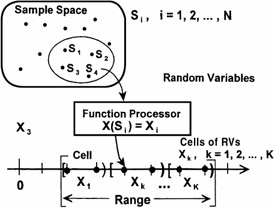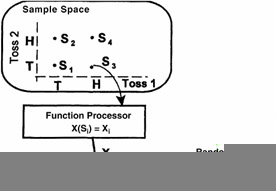RANDOM VARIABLES GROUPED INTO CELLS
RANDOM VARIABLES GROUPED INTO CELLS
-
Group random variables into cells (or " bins ") if the number of random variables is large, say M > 30.
-
Groups or cells are formed in the numerical RV domain by dividing the range into say 10 to 20 equal cells.
-
While the total number of RVs is M, the number of cells is K.
-
All the individual RVs in a cell assume the value of the RV in, say the center of the cell interval and are denoted X k .
-
Each cell or grouping is designated X k and represents a finite interval of contiguous RVs.
Individual:
X i = [(X 1; X 2 , ...), ..., [X i-1 , ..., (X M-1 , X M )]
Cells:
X k = [(X 1 ), ..., (X k ), ..., [X K )]
where X k = X i-1 ‰ X i < X ik
This may be shown as:

RANDOM EXPERIMENT
Two tosses of a coin.

Sample Space: S 1 = TT, S 2 = TH, S 3 = HT, S 4 = HH
Function Process:
-
Assign real-value number to occurrence: T = 0 and H = 1.
-
Sum of real-values for individual samples S i is RV X i .
S 1 = TT ’ X 1 = 0 + 0 = 0
S 2 = TH ’ X 2 = 0 + 1 = 1
S 3 = HT ’ X 3 = 1 + 0 = 1
S 4 = HH ’ X 4 = 1 + 1 = 2
Random Variables: arranged in ascending order by magnitude
{S i } = {TT, TH, HT, HH} ’ {X i } = {0, 1, 1, 2}
Note cell width W c = 1.
EAN: 2147483647
Pages: 252
- Chapter III Two Models of Online Patronage: Why Do Consumers Shop on the Internet?
- Chapter VIII Personalization Systems and Their Deployment as Web Site Interface Design Decisions
- Chapter X Converting Browsers to Buyers: Key Considerations in Designing Business-to-Consumer Web Sites
- Chapter XII Web Design and E-Commerce
- Chapter XIV Product Catalog and Shopping Cart Effective Design